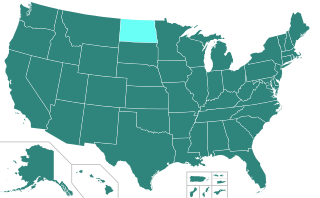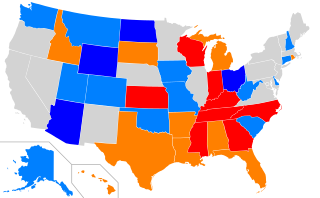Bush v. Gore, 531 U.S. 98 (2000), was a landmark decision of the United States Supreme Court on December 12, 2000, that settled a recount dispute in Florida's 2000 presidential election between George W. Bush and Al Gore. On December 8, the Florida Supreme Court had ordered a statewide recount of all undervotes, over 61,000 ballots that the vote tabulation machines had missed. The Bush campaign immediately asked the U.S. Supreme Court to stay the decision and halt the recount. Justice Antonin Scalia, convinced that all the manual recounts being performed in Florida's counties were illegitimate, urged his colleagues to grant the stay immediately. On December 9, the five conservative justices on the Court granted the stay, with Scalia citing "irreparable harm" that could befall Bush, as the recounts would cast "a needless and unjustified cloud" over Bush's legitimacy. In dissent, Justice John Paul Stevens wrote that "counting every legally cast vote cannot constitute irreparable harm." Oral arguments were scheduled for December 11.

The 2000 United States presidential election recount in Florida was a period of vote recounting in Florida that occurred during the weeks after Election Day in the 2000 United States presidential election between George W. Bush and Al Gore. The Florida vote was ultimately settled in Bush's favor by a margin of 537 votes when the U.S. Supreme Court, in Bush v. Gore, stopped a recount that had been initiated upon a ruling by the Florida Supreme Court. Bush's win in Florida gave him a majority of votes in the Electoral College and victory in the presidential election.
A write-in candidate is a candidate whose name does not appear on the ballot but seeks election by asking voters to cast a vote for the candidate by physically writing in the person's name on the ballot. Depending on electoral law it may be possible to win an election by winning a sufficient number of such write-in votes, which count equally as if the person were formally listed on the ballot.

In elections in the United States, a provisional ballot is used to record a vote when there are questions about a given voter's eligibility that must be resolved before the vote can count. The federal Help America Vote Act of 2002 guarantees that, in most states, the voter can cast a provisional ballot if the voter states that they are entitled to vote.
Palm Beach County Canvassing Board v. Harris(Harris I) was a lawsuit pertaining to the 2000 United States presidential election.

Donald Mark Ritchie is an American politician and a former Minnesota Secretary of State. Ritchie was elected the 21st Minnesota Secretary of State on November 7, 2006. He was re-elected in 2010.

Voter registration in the United States is required for voting in federal, state and local elections. The only exception is North Dakota, although cities in North Dakota may register voters for city elections. Voter registration takes place at the county level in many states and at the municipal level in several states. Most states set cutoff dates for voter registration and to update details, ranging from 2 to 4 weeks before an election; while a third of states have Election Day or "same-day" voter registration which enables eligible citizens to register or update their registration when they vote before or on election day.

The 2008 United States Senate election in Minnesota took place on November 4, 2008. After a legal battle lasting over eight months, the Democratic–Farmer–Labor Party (DFL) candidate, Al Franken, defeated Republican incumbent Norm Coleman in one of the closest elections in the history of the Senate, with Coleman's Senate predecessor Dean Barkley taking third place. Franken took his oath of office on July 7, 2009, more than half a year after the end of Coleman's term on January 3, 2009.

Elections in Oregon are all held using a Vote by Mail (VBM) system. This means that all registered voters receive their ballots via postal delivery and can vote from their homes. A state Voters’ Pamphlet is mailed to every household in Oregon about three weeks before each statewide election. It includes information about each measure and candidate in the upcoming election.

The Wisconsin spring nonpartisan general election was held April 1, 2008. Voters statewide cast ballots for Wisconsin Supreme Court and an amendment to the state Constitution.

Elections in Illinois provide for the election of over 40,000 elected seats across over 6,000 units of government.

The 2012 United States presidential election in New Mexico took place on November 6, 2012, as part of the 2012 United States presidential election in which all 50 states plus the District of Columbia participated. This was the 25th U.S. presidential election in which New Mexico participated. New Mexico voters chose five electors to represent them in the Electoral College via a popular vote pitting incumbent Democratic President Barack Obama and his running mate, Vice President Joe Biden, against Republican challenger and former Massachusetts Governor Mitt Romney and his running mate, Congressman Paul Ryan.

Voter ID laws in the United States are laws that require a person to provide some form of official identification before they are permitted to register to vote, receive a ballot for an election, or to actually vote in elections in the United States.
Voter suppression in the United States consists of various legal and illegal efforts to prevent eligible citizens from exercising their right to vote. Such voter suppression efforts vary by state, local government, precinct, and election. Voter suppression has historically been used for racial, economic, gender, age and disability discrimination. After the American Civil War, all African-American men were granted voting rights, but poll taxes or language tests were used to limit and suppress the ability to register or cast a ballot. The Civil Rights Act of 1964 improved voting access significantly. Since the beginning of voter suppression efforts, proponents of these laws have cited concerns over electoral integrity as a justification for various restrictions and requirements, while opponents argue that these constitute bad faith given the lack of voter fraud evidence in the United States.

Statewide elections in the U.S. state of North Dakota take place every two years. Most executive offices and all legislators are elected to four-year terms, with half the terms expiring on U.S. Presidential election years, and the other half expiring on mid-term election years.

The 2020 United States presidential election in Georgia was held on Tuesday, November 3, 2020, as part of the 2020 United States presidential election in which all 50 states plus the District of Columbia participated. Georgia voters chose electors to represent them in the Electoral College via a popular vote, pitting the Republican Party's nominee, incumbent President Donald Trump of Florida, and running mate Vice President Mike Pence of Indiana against Democratic Party nominee, former Vice President Joe Biden of Delaware, and his running mate Senator Kamala Harris of California. Georgia has 16 electoral votes in the Electoral College.

The 2020 United States presidential election in Minnesota was held on Tuesday, November 3, 2020, as part of the 2020 United States presidential election in which all 50 states plus the District of Columbia participated. Minnesota voters chose electors to represent them in the Electoral College via a popular vote, pitting the Republican Party's nominee, incumbent President Donald Trump, and running mate Vice President Mike Pence against the Democratic Party nominee, former Vice President Joe Biden, and his running mate California Senator Kamala Harris. Minnesota has ten electoral votes in the Electoral College.

The 2020 Minnesota Democratic presidential primary took place on March 3, 2020, as one of 15 contests scheduled on Super Tuesday in the Democratic Party primaries for the 2020 presidential election, following the South Carolina primary the weekend before. The Minnesota primary, only the fifth in the state's history and the first since 1992, was an open primary, with the state awarding 91 delegates towards the 2020 Democratic National Convention, of which 75 were pledged delegates allocated on the basis of the results of the primary. Early voting was possible for just over six weeks beginning January 17, 2020.

The 2020 Wisconsin Fall General Election was held in the U.S. state of Wisconsin on November 3, 2020. All of Wisconsin's eight seats in the United States House of Representatives were up for election, as well as sixteen seats in the Wisconsin State Senate and all 99 seats in the Wisconsin State Assembly. Voters also chose ten electors to represent them in the Electoral College, which then participated in selecting the president of the United States. The 2020 Fall Partisan Primary was held on August 11, 2020.

Texas state elections in 2020 were held on Tuesday, November 3, 2020. Its primaries were held on March 3, 2020, with runoffs taking place on July 14.















